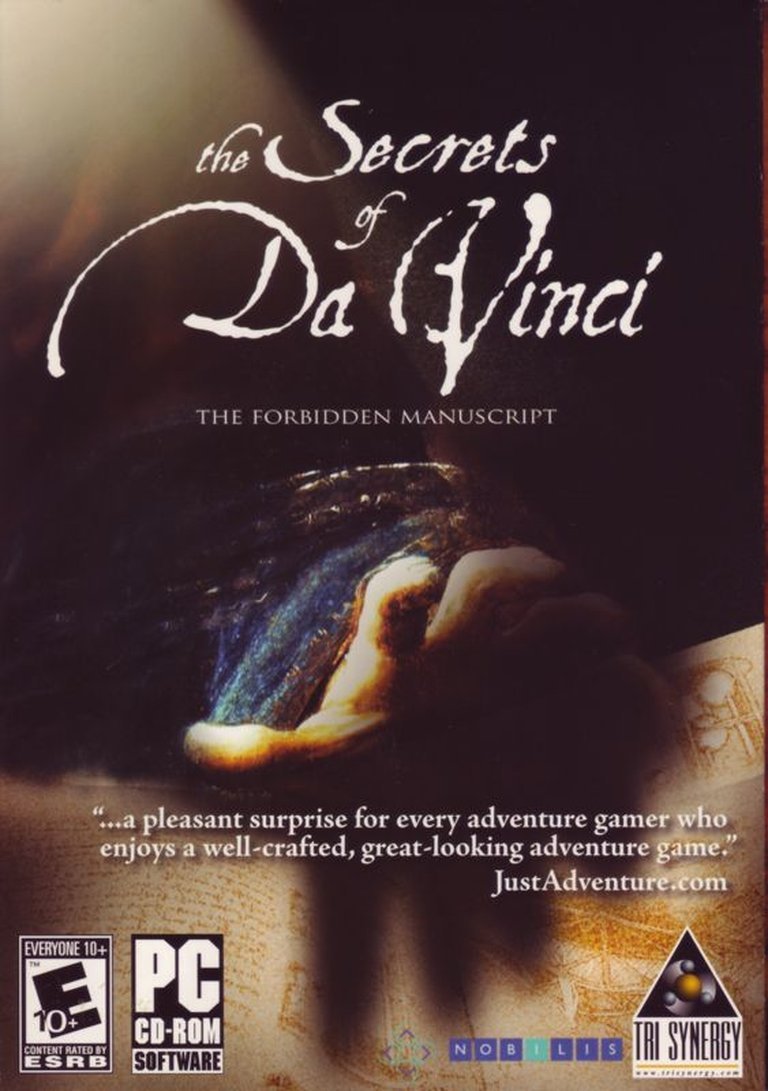- Release Year: 2006
- Platforms: iPad, Macintosh, Windows Mobile, Windows
- Publisher: Coladia Games, Nobilis France, Nobilis Ibérica, Noviy Disk, Tetraedge S.A., Tri Synergy, Inc., UIG Entertainment GmbH
- Developer: Coladia Games, Elektrogames Limited Company, Kheops Studio, TOTM Studio Games SARL
- Genre: Adventure, Educational
- Perspective: First-person
- Game Mode: Single-player
- Gameplay: Crafting, Graphic adventure, Moral choices, Multiple endings, Point-and-click, Puzzle elements
- Setting: 16th Century, Europe, Italy
- Average Score: 73/100

Description
The Secrets of Da Vinci: The Forbidden Manuscript is an adventure game set in 1522 Italy, where you play as Valdo, an apprentice tasked with uncovering Leonardo da Vinci’s secret notebook. Navigate da Vinci’s estate, solve puzzles based on his inventions, and interact with historical figures in this point-and-click mystery that blends logic, science, and alchemy.
Gameplay Videos
The Secrets of Da Vinci: The Forbidden Manuscript Cracks & Fixes
The Secrets of Da Vinci: The Forbidden Manuscript Guides & Walkthroughs
The Secrets of Da Vinci: The Forbidden Manuscript Reviews & Reception
metacritic.com (69/100): While this is not a game I’d replay over and over again, it was a great deal of fun.
myabandonware.com (95/100): ahh the nostalgia! this game was also released in Poland as an extra CD for the Gala magazine
eurogamer.net (60/100): The Secrets of Da Vinci is all about the puzzles, of which it contains two types – the standard use item X on object Y” adventure fare and mini-game puzzles.
The Secrets of Da Vinci: The Forbidden Manuscript Cheats & Codes
PC
Press the specified function keys in the game to activate each cheat.
| Code | Effect |
|---|---|
| F1 | Change Crystals |
| F2 | Enemies Don’t Attack |
| F3 | Set Gold |
| F4 | Unlimited Weapon Durability |
| F5 | Super Acceleration |
| F6 | Add Money |
| HOME | Disable All |
The Secrets of Da Vinci: The Forbidden Manuscript: Review
Introduction
The Secrets of Da Vinci: The Forbidden Manuscript is a 3D first-person adventure game set in 1522 at Leonardo Da Vinci’s last home, Cloux Manor (now the Château du Clos Lucé). You play Valdo, an apprentice searching for Da Vinci’s secret manuscript while navigating puzzles inspired by the master’s real works. The game blends historical exploration with inventive problem-solving across four chapters, offering multiple endings based on player choices.
Development History & Context
Developed by Kheops Studio and co-produced with Nobilis, Elektrogames, TOTM Studio, and Mzone Studio, this game was released in 2006 amidst the Da Vinci Code craze. However, it stands as its own experience. The team collaborated closely with Chateau du Clos Lucé to ensure historical accuracy and recreate the estate in meticulous detail. Key developers included Olivier Train (director/art director) and Marianne Tostivint (game designer), who aimed to balance educational value with engaging gameplay.
Narrative & Thematic Deep Dive
The story follows Valdo as he explores the manor, interacting with characters like Babou de la Bourdaisière and caretaker Saturnin. The narrative is ripe with mystery, romance, and danger. Themes include:
- Legacy of Genius: Learning about Da Vinci’s life and works through integrating his inventions and notes into puzzles
- Moral Choice: Navigating a good/bad karma system that affects gameplay and endings
- Historical Setting: Immerging players in 16th-century France with authentic decor and clothing
- Intrigue and Betrayal: Unraveling a plot where trust is uncertain and motives hidden
Gameplay Mechanics & Systems
- Point-and-Click Interface: Classic adventure game controls with cursor-based interactions
- Inventory Management: Complex system with multiple pages, crafting tools, and context-sensitive use
- Puzzle Variety: Mechanical, scientific, and alchemical challenges based on Da Vinci’s actual work
- Journal System: Interactive notes with puzzles and clues crucial for progress
- Character Interactions: Limited but impactful conversations with main NPCs like Babou and Saturnin
- 章节结构: 四章节设计,每个章节对应一天时间,部分任务可在章节间继承
- Multiple Endings: Different story outcomes based on player actions and choices
Notable gameplay elements:
– Good/Bad Meter: Two bars tracking moral choices, affecting available actions and outcomes
– Crafting System: Creating items like ink, gunpowder, and metal alloys using period-appropriate methods
– Transport Puzzles: Repairing and using Da Vinci’s inventions like the flying machine and rotating bridge
World-Building, Art & Sound
The game excels in its art direction, with detailed 3D models replicating the chateau’s architecture and grounds. Key areas include the workshop, Leonardo’s bedroom, and the dovecot. The atmospheric soundtrack evokes the Renaissance era, and ambient sounds like crackling fireplaces and chirping birds enhance immersion.
Reception & Legacy
The Secrets of Da Vinci: The Forbidden Manuscript received mixed reviews, with scores averaging around 70%. Critics praised the visual fidelity, historical accuracy, and puzzle design but critiqued tech issues like long load times, limited character interactions, and occasional unhelpful puzzle clues.
While not a commercial blockbuster, it inspired later European adventure games and influenced other Da Vinci-themed titles like The House of Da Vinci. Its cross-platform releases (Windows, macOS, iOS) increased accessibility, and its commitment to historical accuracy remains a highlight.
Conclusion
The Secrets of Da Vinci: The Forbidden Manuscript stands as a solid entry in the Da Vinci-adventure canon. It offers an atmospheric journey through 16th century France with engaging puzzles, moral choices, and a rich setting. Though marred by some gameplay frustrations, its unique combination of history and mystery makes it a worthy addition to any adventure gamer’s library, especially those with an interest in Da Vinci’s legacy or point-and-click puzzle games.